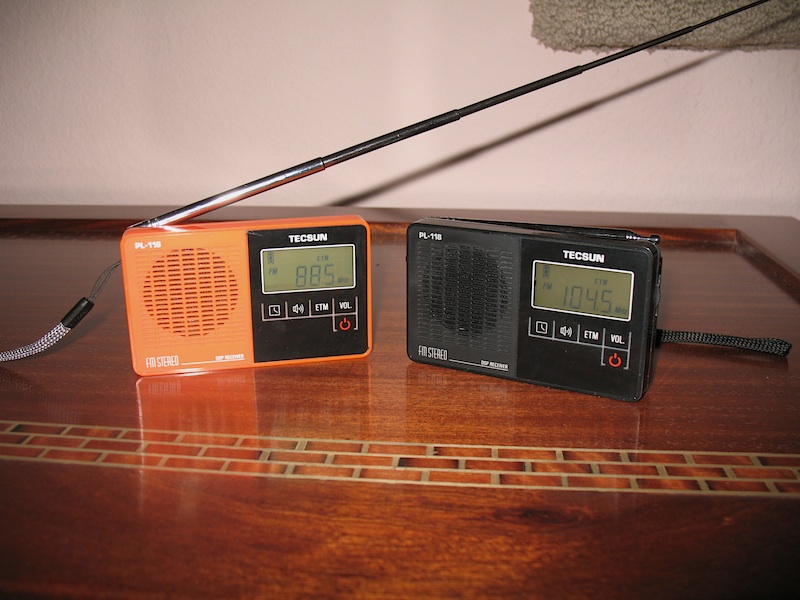
The Chinese radio manufacturer Tecsun keeps cranking out the hits. This time, it's the PL-118 FM-only DSP radio. It's a very small radio. Unlike other Tecsun DSP-based radios, this one keeps the number of buttons and controls at a minimum. It's available in the using boring black, but also in white and in orange.
I bought two, one of the office and one for travel.
Let's address the controls first. Instead of push buttons, the PL-118 uses pressure-sensitive pads. It doesn't have a "lock" feature, so it is possible to push hard enough and accidentally set a function.
There's one knob, which serves both as a tuning knob and a volume control. To use the knob as a volume control, you first have to push the VOL button. It sounds inconvenient to use, but in practice, I didn't find it to be a problem.
A feature not found on any other Tecsun radio (that I know of) until now, is an automatic volume adjustment for headphones. When you plug headphones in, the volume drops automatically to a lower, preset level. You can increase or decrease the volume after that. When you unplug the headphones, the volume increases to a higher, preset level, which is also subsequently adjustable. When using headphones, stereo reception is enabled. Generally speaking, the Tecsun volume control on this radio has more gradation and finesse than the controls on other Tecsun radios I've had.
There is no standard memory function, but there is Easy Tuning Mode (ETM), which turns out to be extremely useful on this radio. ETM scans for stations and then adds them to memory. You can use the tuning dial to switch between stations that have been memorized in this way. You can also turn off ETM and tune in 100 kHz increments.
When the radio is off, the ETM button is used in conjunction with the tuning knob to select the FM reception range for various parts of the world.
There's also a clock and an alarm function -- no beeper, just the radio. The radio runs on 2 AAA batteries. It has no charging capabilities.
The telescoping antenna is way too short for peak FM performance -- just over 13 inches. This is probably the one thing that limits this radio's performance.
To test the PL-118's performance, I took the radio with me on a vacation to northern San Luis Obispo county (in California). There are quite a few translators around there, plus only one station broadcasting in HD. So "false hits" from HD sidebands are rare. For comparison, I brought along one of my Tecsun PL-606s.
A telling measurement is the number of stations that ETM picked up (both radios have Easy Tuning Mode). The PL-606 picked up a net of 39 stations, excluding spurious signals. The PL-118 picked up 26, all valid. The PL-118 wasn't able to pick up a few of the more distant translators, and couldn't pick up KTEA from Cambria, which the PL-606 could pick up.
The stubby antenna limits the PL-118's capabilities. (A clip-on extender might help matters.) Otherwise, the PL-118 was free from cross-modulation and other artifacts of signal overload, just as you'd expect from a DSP-based radio.
Another time, though, in my San Francisco office, where FM signals go to die, I found something interesting. I was using my Tecsun PL-118 on a signal shredded by multipath. Then I shortened the antenna to its shortest length. Reception got much better. I should have remembered: in high-signal urban environments, sometimes reducing signal strength will make for better reception -- because you're making it harder for weaker, redundant signals to reach the radio and cause interference. It's a lesson not limited to the PL-118, and one worth remembering.
The compact size is a winner, even though I wish the radio came with a protective case, and the radio focuses on the thing that DSP-based radios do best: FM reception.
With shipping, I paid $20 each for the PL-118s, purchased through my favorite Hong Kong reseller on eBay.
A nice, and colorful, travel combination might be the Sangean DT-400W for AM and weather-band reception (the Sangean's FM reception capabilities are so-so at best) and the PL-118 for FM. But, on balance, I think the PL-606 is better, and more versatile. But it is bigger. Where space is at a premium, the PL-118 is a reasonable choice, and is far better than many other portables.